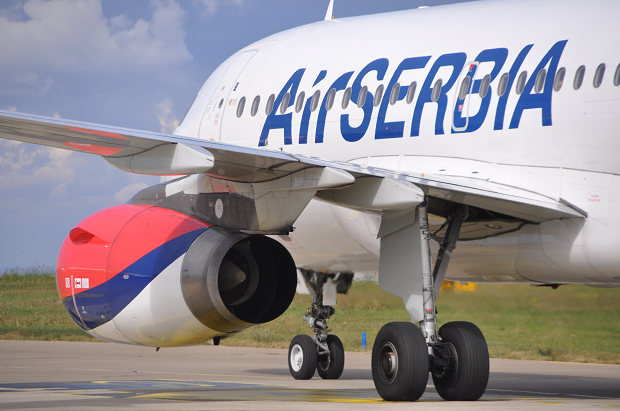The very day this week it was announced that Etihad Group CEO James Hogan is stepping down later this year, Air Serbia turned out be the winner of the coveted Airline Market Leader award 2016 by Air Transport World. As James Hogan leaves a very mixed legacy of mostly lossmaking carriers within the Etihad Airways Partner (EAP) group he created, at least one of his acquisitions seems to blossom. A rare exception among huge ongoing losses being incurred particularly by Air Berlin and Alitalia, the latter once more on the brink of bankruptcy. For Air Serbia, however, Hogan’s vision is materializing, after he sent fellow Australian Dane Kondic, a Sydneysider and son of Bosnian Serb immigrants, to his parent’s country in 2013 to take over the former Yugoslav state carrier JAT as CEO and reinvent the airline. Which he did. The most visible achievement was the relaunch of long-haul flights from Belgrade to New York last year.
On June 23, 2016, for the first time since 1992, a nonstop flight from the Balkans, long cut off from intercontinental air traffic, landed on US soil. “The whole country watched the live coverage of the arrival on TV here”, reports Air Serbia’s COO Davor Miseljic in talking to Airlineratings in Belgrade. But since Etihad took over 49% of the shares from the Serbian government and reinvented the carrier as Air Serbia, everything seems to be possible, including five weekly flights on the Belgrade to New York route with the carrier’s sole Airbus A330. Passenger numbers for the route were 40% above the business plan after the first half year, only yields didn’t perform as hoped for, due to less Americans traveling on the route to Europe for fear of terror attacks, according to the airline.
“If we wouldn’t be a partner of Etihad there is no way on earth we would have been able to realize the ambition to fly to the US,” stresses Dane Kondic, CEO of Air Serbia, in an interview with Airlineratings. “We decided that with EAP synergies and low fuel prices it was now or never for our JFK route.” And indeed, the advantages of the airline group played an important role in the implementation of the flight: “The aircraft comes from Jet Airways in India, the pilots were trained at Alitalia, cabin crews at Etihad, the aircraft are serviced between Rome and Abu Dhabi and our GSA in the US is Etihad. That’s living, breathing proof of synergy in action,” says Kondic. That’s what Etihad boss James Hogan had in mind apparently, as after long hesitation he decided to invest in the former Yugoslav state carrier, considered to be a hopeless case. “When an airline is broken and it’s on the edge of vanishing forever, you have to be very hard nosed on how you intend to turn it around,” said Hogan.
“The Balkans is a huge market and all the carriers in the Balkans are broken,” he described his motivation in turning Air Serbia into the region’s most important carrier. The ethnic travel market in Serbia alone is big, reaching from Australia to North America, where many people with Serbian roots live. Serbia is only a fifth in size compared to former Yugoslavia, its formerly biggest federal state ranks 22nd in population in Europe, just before Denmark. Since 2006 Serbia is sole legal successor of Yugoslavia and also heir of JAT, the second-oldest airline in the world, whose predecessor Aeroput was already founded back in 1927.
“We could not start with a clean slate, we inherited all the problems of JAT,” says Dane Kondic. Most urgently, the ageing and uninspired service staff of the predecessor airline had to go. Still in 2010, JAT had about 1,900 people on its pay roll, while no significant flight operations happened. After voluntary redundancies and then the hiring of new flight attendants later, the Air Serbia group employs about 2,500 staff members today, among them 221 pilots, mostly Serbs. “We managed to move very quickly and focused on turning this business around,” says Kondic, “we have done a lot of things here in three years that other airlines wouldn’t do in ten years.”
With a fleet of just eleven jets, eight Airbus A319s, two A320s as well as the sole A330, Air Serbia serves eight seasonal destinations and 36 the whole year round, ranging from New York to Abu Dhabi, including five in Germany as the biggest market. Passenger numbers are rising slowly but steady, to around 2.7 million in 2016. “It was clear to us that this is a marathon, not a 100-meter sprint,” says Dane Kondic, “we are currently developing a strategic five-year plan. There are no plans to order more wide-bodies, but looking at it, when you get a second aircraft, you get a lot more synergies as well,” the CEO acknowledges. Beijing is seen as a second viable long-haul destination from Belgrade. The carrier will receive its first of ten A320neos on order by the end of 2018, part of a bulk order from Etihad for 45 aircraft.
Even as it is hard to predict how Etihad’s partner strategy, which is regarded as having at least partially failed, will be pursued by a successor to James Hogan, Air Serbia is a positive example of the spirit behind it. “We suffered a quarter century of decline here in Serbia, which erodes your morale and your faith into a better future,” says COO Davor Miseljic. “Now at Air Serbia, we are a positive example of how things can be turned around, a lighthouse project for the nation, of how we Serbians are able to do it with some outside help.”
























